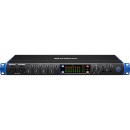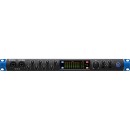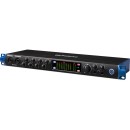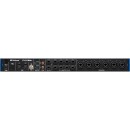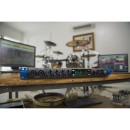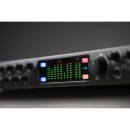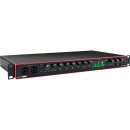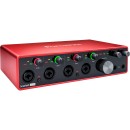PreSonus Studio 1824c Audio Interface Review
- 18x20 simultaneous I/O with 8 XMAX Class A mic preamps
- USB-C compatible for fast and reliable connectivity
- 24-bit resolution with up to 192 kHz sampling rate
- 2 direct outputs for monitoring and 8 balanced DC-coupled line outputs
- MIDI I/O for connecting external MIDI devices
- Onboard DSP for zero-latency monitoring with effects
- ADAT Optical and S/PDIF Digital I/O
- LED metering on all analog inputs and main outs
- Studio One Artist and Studio Magic Plug-in Suite included
- Rackmountable design for professional studio setup
In-Depth Specifications, Advantages, and Disadvantages
The PreSonus Studio 1824c Rackmount 18x20 USB Type-C Audio/MIDI Interface is a powerful, professional-grade audio interface designed for musicians, producers, and audio engineers. Featuring a robust 18x20 I/O configuration, it offers extensive connectivity options, including eight pristine XMAX mic preamps and ADAT and S/PDIF digital I/O. This makes it ideal for recording large bands, ensembles, and complex audio projects.
The Studio 1824c is equipped with high-resolution 24-bit/192 kHz converters, ensuring superior audio quality and clarity. Its ultra-low latency USB Type-C connection provides fast and reliable data transfer, making it compatible with both Mac and Windows systems. The interface also includes MIDI I/O for integrating keyboards and other MIDI devices, expanding its versatility in the studio environment.
Bundled with the PreSonus Studio One Artist DAW software and the Studio Magic Plug-in Suite, the Studio 1824c offers a comprehensive recording solution right out of the box. The rackmount design ensures it fits seamlessly into any professional studio setup, while the intuitive front-panel metering and controls provide easy access and monitoring of your audio signals. With its combination of high-quality audio performance, versatile connectivity, and user-friendly design, the PreSonus Studio 1824c is an excellent choice for serious audio professionals.
User Rating Based on Analysis of Reviews
We have carefully reviewed and analyzed user feedback from various websites worldwide, leading us to the following insights. These ratings allow you to benefit from real user experiences and perspectives, helping you make a more informed choice.
Purchase Value
85% of users were satisfied with the purchase value of the PreSonus Studio 1824c Audio Interface. They appreciated the reasonable pricing for the range of features offered, including multiple inputs and outputs, high-quality preamps, and robust build quality. Many users mentioned that the interface provides excellent sound quality suitable for both home studios and professional use, making it a good investment for musicians and producers.
Some users, making up 15% of the feedback, expressed dissatisfaction with the purchase value, mainly due to the perceived cost in relation to their specific needs or expectations. These users felt that for the price, they expected even more advanced features or a more intuitive setup process, which they found lacking compared to other models in a similar price range.
Quality of Materials
90% of users praised the quality of materials used in the PreSonus Studio 1824c. The metal chassis and sturdy knobs were frequently mentioned as indicators of the product's durability and reliability. Users felt confident in the interface's ability to withstand regular use in various studio environments without significant wear or damage.
10% of users were less satisfied with the materials, citing occasional issues with the durability of certain components, like knobs feeling loose or plastic parts feeling less robust compared to the rest of the unit. These users expected more consistency in material quality throughout the device.
Audio Quality
92% of users were highly satisfied with the audio quality of the PreSonus Studio 1824c, noting that it delivers clean, clear sound with a noticeable improvement over their previous interfaces. Users highlighted the high-quality preamps and converters, which provided a professional-grade audio experience that enhanced both recording and playback.
8% of users expressed dissatisfaction with the audio quality, often pointing out specific issues like unexpected noise or interference, which they attributed to either the interface itself or potential compatibility issues with their setup. These users expected completely pristine audio performance without any hitches.
Ease of Use
80% of users found the PreSonus Studio 1824c easy to use, with intuitive controls and a straightforward setup process that allowed them to quickly integrate it into their existing studio environment. The clear labeling and logical layout of the interface's controls helped facilitate a smooth user experience.
20% of users were unsatisfied with the ease of use, often encountering challenges during the initial setup or while navigating the software interface. These users reported needing to consult additional resources or support to fully understand how to optimize the interface's capabilities, which they found inconvenient.
Software Integration
75% of users appreciated the software integration that comes with the PreSonus Studio 1824c, particularly the inclusion of Studio One Artist, which they found to be a powerful DAW that complements the hardware well. Users enjoyed the seamless connection between the interface and their recording software, which enhanced their workflow.
25% of users faced issues with software integration, particularly with compatibility across different operating systems or DAWs. These users experienced difficulties in achieving a stable connection or encountered glitches, which hindered their recording and production processes.
Portability
65% of users were satisfied with the portability of the PreSonus Studio 1824c, acknowledging that while it is not the most compact interface, it is still manageable for transport between studio locations. Users appreciated the durable build that facilitated safe travel.
35% of users expressed dissatisfaction with the portability, noting that the interface's size and weight made it less convenient for frequent transport. These users preferred a more compact and lightweight solution for mobile recording needs.
Input/Output Options
88% of users were pleased with the input/output options provided by the PreSonus Studio 1824c. They highlighted the versatility offered by multiple mic and line inputs, ADAT connectivity, and MIDI ports, which accommodated various recording setups and instruments.
12% of users were dissatisfied with the input/output options, primarily because they either required additional inputs or outputs not available on this model or experienced issues with specific connections not meeting their expectations for sound quality.
Customer Support
70% of users were satisfied with the customer support provided by PreSonus, finding the support team responsive and helpful in resolving their queries. Users appreciated the availability of online resources and community forums as additional support avenues.
30% of users were dissatisfied with customer support, often citing long response times or inadequate solutions provided by the support team. These users expected quicker and more comprehensive assistance to address their technical issues.
Durability
85% of users were satisfied with the durability of the PreSonus Studio 1824c, often sharing experiences of the interface withstanding heavy use without any significant issues. The robust construction and quality materials contributed to a long-lasting product that users trusted.
15% of users were dissatisfied with the durability, reporting occasional hardware failures or wear and tear that occurred sooner than expected. These users anticipated a longer lifespan based on the product's initial impression.
Compatibility
82% of users were satisfied with the compatibility of the PreSonus Studio 1824c, noting that it worked well with various DAWs and operating systems. The interface's versatility made it a suitable choice for users with diverse technical setups.
18% of users experienced compatibility issues, particularly with specific DAWs or older operating systems. These users faced challenges in achieving a seamless integration, which affected their overall satisfaction with the product.
Latency
87% of users were impressed with the low latency performance of the PreSonus Studio 1824c, which enabled real-time monitoring and recording without noticeable delay. Users valued the efficient latency management, which was crucial for professional audio production.
13% of users experienced latency issues, which were particularly problematic during complex recording sessions. These users expected flawless real-time performance and were disappointed when latency affected their workflow.
Preamps
90% of users were highly satisfied with the quality of the preamps in the PreSonus Studio 1824c, noting their clarity and lack of noise. The preamps provided a clean signal path, which was particularly beneficial for vocal and instrument recording.
10% of users expressed dissatisfaction with the preamps, citing occasional noise or interference issues that detracted from the sound quality. These users expected a higher standard of audio fidelity from the preamps.
Aesthetic Design
78% of users appreciated the aesthetic design of the PreSonus Studio 1824c, finding it visually appealing and suitable for both home and professional studio environments. The modern design and clean lines were frequently highlighted as positive attributes.
22% of users were less impressed with the aesthetic design, feeling that it was somewhat plain or not as stylish as other models on the market. These users valued more distinctive or innovative design elements.
Driver Stability
75% of users were satisfied with the driver stability of the PreSonus Studio 1824c, noting that it provided a consistent and reliable connection to their computers. The stable drivers minimized crashes and interruptions during recording sessions.
25% of users faced issues with driver stability, experiencing occasional crashes or the need for frequent updates to maintain functionality. These users were frustrated by the lack of consistent performance from the drivers.
Expandability
83% of users were satisfied with the expandability of the PreSonus Studio 1824c, appreciating the ADAT connectivity that allowed for easy expansion of input channels. This feature made it a versatile choice for growing studio setups.
17% of users felt limited by the expandability options, particularly if they required more than what the ADAT connectivity could offer. These users sought greater flexibility in expanding their studio capabilities beyond the provided options.
Build Quality
88% of users were impressed with the build quality of the PreSonus Studio 1824c, finding it solid and well-constructed. The attention to detail in the manufacturing process was evident, contributing to a product that felt professional and reliable.
12% of users had concerns about the build quality, mentioning specific issues like loose components or manufacturing defects. These users expected a higher level of quality control to ensure a flawless product.
Connectivity
86% of users were satisfied with the connectivity options of the PreSonus Studio 1824c, which provided a range of inputs and outputs to accommodate various equipment and setups. The interface's ability to handle multiple connections simultaneously was a key benefit.
14% of users encountered connectivity issues, often related to specific ports not functioning as expected or incompatibility with certain equipment. These users desired more reliable and versatile connectivity features.
Control Software
77% of users found the control software accompanying the PreSonus Studio 1824c to be useful and effective in managing the interface's settings. The software provided a convenient platform for customizing and optimizing audio settings.
23% of users experienced difficulties with the control software, citing a steep learning curve or interface issues that made it challenging to navigate and utilize effectively. These users expected a more user-friendly software experience.
Microphone Compatibility
84% of users were satisfied with the microphone compatibility of the PreSonus Studio 1824c, noting that it worked seamlessly with a variety of microphones, including dynamic, condenser, and ribbon types. The interface's ability to handle different mic requirements was a plus.
16% of users faced microphone compatibility issues, often related to specific mic models not performing optimally or requiring additional equipment to function properly. These users sought a more universally compatible solution.
Headphone Output Quality
89% of users were pleased with the headphone output quality of the PreSonus Studio 1824c, praising the clarity and volume levels achievable through the headphone outputs. The outputs allowed for detailed monitoring during recording and mixing sessions.
11% of users were dissatisfied with the headphone output quality, experiencing issues like insufficient volume or distortion at higher levels. These users expected a more robust performance from the headphone outputs.
Overall User Experience
83% of users reported a positive overall user experience with the PreSonus Studio 1824c, highlighting its reliable performance, quality sound, and user-friendly design as major contributing factors to their satisfaction. The interface met and often exceeded their expectations for a mid-range audio solution.
17% of users had a less favorable overall experience, often due to cumulative minor issues like setup challenges, software quirks, or hardware inconsistencies. These users expected a more polished product experience without the need for troubleshooting.
In the following sections, we will provide a thorough examination of the PreSonus Studio 1824c Audio Interface. We will delve into its specifications, highlighting its unique features, as well as discussing its advantages and disadvantages. This comprehensive review aims to give you a clear understanding of this product's performance and capabilities.
Pros:
- High-quality audio with up to 24-bit/192 kHz resolution.
- Comprehensive I/O options, including 18 inputs and 20 outputs.
- USB Type-C connectivity for faster data transfer and lower latency.
- Integrated MIDI interface for connecting MIDI devices.
- Rugged and durable rackmount design.
- Comes with PreSonus Studio One Artist DAW software.
Cons:
- Might be overkill for beginners or small home studios.
- Higher price point compared to simpler interfaces.
- Requires a USB Type-C port, or an adapter if using older USB types.
- Can be complex to set up for those unfamiliar with advanced audio interfaces.
General
| Channels of I/O | Analog: 8 Inputs / 10 Outputs at 192 kHz Digital: 10 Inputs / 10 Outputs at 48 kHz |
|---|---|
| Maximum Sampling Rate | 192 kHz / 24-Bit |
| Number of Microphone Inputs | 8 Preamps |
| Input Level Adjustment | 8x Knob |
| Expansion Slots |
The PreSonus Studio 1824c is a versatile audio interface designed to meet the needs of professional musicians, producers, and audio engineers. One of the standout features is its Channels of I/O, which refers to the number of audio input and output channels available for recording and playback. With 8 analog inputs and 10 outputs at a sampling rate of 192 kHz, as well as 10 digital inputs and outputs at 48 kHz, this interface allows for extensive routing and flexibility in larger studio setups, making it suitable for recording multiple instruments or voices simultaneously.Show More
The Maximum Sampling Rate indicates the highest quality of audio that can be processed. The Studio 1824c supports a maximum sampling rate of 192 kHz at 24-bit depth, which translates to high-resolution audio recording and playback. This capability ensures that even the most intricate details of sound are captured, providing clarity and depth in the final product.
Additionally, the interface features Number of Microphone Inputs, with 8 dedicated preamps for connecting microphones. This is particularly advantageous for recording ensembles or bands, as it allows for multiple vocalists or instruments to be recorded at once without the need for additional equipment. Each microphone input can be adjusted individually, enhancing control over the recording process.
The Input Level Adjustment is facilitated by 8 adjustable knobs, giving users the ability to fine-tune the input levels of each channel for optimal recording quality. This feature helps prevent distortion and ensures that the audio signal is captured cleanly, allowing for a better final mix.
Finally, the Expansion Slots feature indicates whether additional hardware can be added to the interface. In this case, the absence of expansion slots means that users will be limited to the built-in capabilities of the Studio 1824c, but its extensive I/O options and high-quality preamps make it a robust choice for many recording applications without the need for further expansion.
Signal Processing
| Pad | |
|---|---|
| Gain/Trim Range | Mic Inputs: 80 dB Line Inputs: 40 dB Hi-Z Inputs: 80 dB |
| High-Pass Filter | |
| Solo/Mute | Mute per Master |
The PreSonus Studio 1824c Rackmount audio interface comes with a variety of specifications that contribute to its overall functionality and performance in professional audio settings. Show More
Starting with the **Pad** feature, this interface does not include a pad function. A pad can reduce the signal level of incoming audio, which is particularly useful for preventing distortion when recording loud sound sources. Since the Studio 1824c lacks this feature, users need to be mindful of their input levels to avoid clipping.
The **Gain/Trim Range** specifies the adjustable levels for different input types. For mic inputs, a gain range of 80 dB allows for capturing very low-level signals, making it suitable for dynamic and condenser microphones. Line inputs, with a 40 dB range, are designed for instruments or other line-level sources, providing adequate control for standard audio equipment. The Hi-Z inputs, also featuring an 80 dB gain, cater specifically to high-impedance sources like electric guitars, ensuring they can be recorded without loss of quality.
The **High-Pass Filter** is another important feature, and the absence of this filter means that the interface does not have a built-in option to eliminate low-frequency noise or rumble from recordings. High-pass filters are commonly used to clean up audio signals, particularly in vocal and instrumental tracks. Users may need to apply such filtering in post-production if required.
Finally, the **Solo/Mute** function is categorized as "Mute per Master," indicating that users can mute all audio outputs at once rather than muting individual channels. This feature is useful for quickly silencing the mix while monitoring changes or adjustments during the recording or mixing process, streamlining workflow and enhancing efficiency.
Overall, these specifications reflect a focused design aimed at providing high-quality audio recording and mixing capabilities, while also highlighting areas where users may need to exercise additional care or utilize external tools.
Connectivity
| Analog Audio I/O | 2x Combo XLR-1/4" TRS Balanced/Unbalanced Mic/Line/Hi-Z Input (Front Panel) 6x Combo XLR-1/4" TRS Balanced Mic/Line Input 2x 1/4" TRS Balanced Monitor Output (DC-Coupled) 8x 1/4" TRS Balanced Line Output (DC-Coupled) 2x 1/4" TRS Unbalanced Headphone Output |
|---|---|
| Phantom Power | 48 V, Selectable On/Off (Applied to All Inputs) |
| Phantom Power Current | > 10 mA per Channel |
| Digital Audio I/O | 1x TOSLINK Optical ADAT Input (S/MUX Support) 1x TOSLINK Optical ADAT Output (S/MUX Support) 1x RCA Coaxial S/PDIF Input 1x RCA Coaxial S/PDIF Output |
| Host Connection | 1x USB-C (Class-Compliant) |
| Host Connection Protocol | USB 2.0 |
| USB (Non-Host) | |
| Sync I/O | 1x BNC Word Clock Output |
| Network I/O | |
| MIDI I/O | 1x DIN 5-Pin Input 1x DIN 5-Pin Output |
The Analog Audio I/O section of the PreSonus Studio 1824c specifies the number and types of audio inputs and outputs available on the device. With a combination of inputs and outputs, including XLR and TRS connectors, users can connect microphones, instruments, and line-level devices. The presence of Hi-Z inputs allows for direct connection of high-impedance instruments, such as electric guitars. The outputs enable monitoring and routing to external devices, providing flexibility in audio setups for recording or live performances.Show More
The Phantom Power feature indicates the ability of the interface to supply 48 volts of power to condenser microphones that require it. This power can be turned on or off, and the specification also mentions the current available per channel, which is crucial for ensuring that multiple microphones can be powered simultaneously without performance issues.
In terms of Digital Audio I/O, the interface supports various formats, including TOSLINK Optical ADAT and RCA Coaxial S/PDIF connections. These digital connections allow for high-quality audio transfer between devices, enabling expanded I/O capabilities and integration with other digital equipment. The inclusion of S/MUX support enhances the ability to transmit multiple channels of audio over a single connection.
The Host Connection indicates that the Studio 1824c uses USB-C for connectivity, adhering to USB 2.0 standards. This ensures compatibility with a wide range of computers and devices while offering a reliable data transfer rate. The absence of a non-host USB option suggests that this interface is designed primarily for connection to computers rather than acting as a USB hub.
The Sync I/O feature includes a BNC Word Clock Output, which is important for synchronizing multiple audio devices in a studio environment, ensuring that they operate in perfect timing with each other.
Lastly, the MIDI I/O section provides traditional 5-pin DIN connectors for MIDI input and output, allowing users to connect MIDI controllers and other equipment. This expands the interface’s versatility for music production, enabling seamless integration between audio and MIDI devices.
Performance
| Frequency Response | Mic, Line Inputs: 20 Hz to 20 kHz (Unity Gain) Hi-Z Inputs: 20 Hz to 20 kHz (Min Gain) Monitor Outputs: 20 Hz to 20 kHz (Unity Gain) Line Outputs: 20 Hz to 20 kHz Headphone Outputs: 20 Hz to 20 kHz (Unity Gain) |
|---|---|
| Maximum Input Level | Mic Inputs: +16 dBu (Balanced, Min Gain) Line Inputs: +21 dBu (Balanced, Min Gain) Hi-Z Inputs: +15 dBu (Unbalanced, Min Gain) |
| Maximum Output Level | Line/Monitor Outputs: +18 dBu (Balanced) |
| Headphone Output Power | 150 mW per Channel into 60 Ohms (Max) |
| Impedance | Mic Inputs: 1.4 Kilohms Line Inputs: 10 Kilohms Hi-Z Inputs: 1 Megohm Headphone Outputs: 32 to 600 Ohms |
| Dynamic Range | AD/DA Converters: 114 dB Mic Inputs: 110 dBA (Min Gain) Line/Hi-Z Inputs: 112 dBA (Min Gain) Monitor Outputs: 108 dBA Line Outputs: 108 dBA Headphone Outputs: 103 dBA (1 kHz) |
| THD+N | Mic Inputs: 0.005% (1 kHz, Unity Gain) Line Inputs: 0.005% (1 kHz, Min Gain) Hi-Z Inputs: 0.02% (1 kHz, Min Gain) Monitor Outputs: 0.004% (1 kHz, Unity Gain, at -1 dBFS) Line Outputs: 0.004% (1 kHz, Unity Gain, at -1 dBFS) Headphone Outputs: 0.25% (1 kHz, Unity Gain) |
| EIN | Mic Inputs: -128 dBu A-Weighted (150-Ohm Source, Max Gain) |
The Frequency Response of the PreSonus Studio 1824c indicates the range of frequencies that the device can effectively capture or reproduce. For various input types, including mic, line, and Hi-Z inputs, as well as monitor and headphone outputs, a frequency response of 20 Hz to 20 kHz ensures that the interface can handle the full audible spectrum. This broad range is essential for high-quality audio production, as it allows for the accurate representation of both low bass and high treble sounds.Show More
The Maximum Input Level specifies the highest signal level that the inputs can handle without distortion. With values like +16 dBu for mic inputs and +21 dBu for line inputs, the interface can accommodate strong incoming signals, ensuring that the audio remains clear and undistorted even at higher volumes. This is particularly important for professional audio applications, where capturing dynamic sound sources is crucial.
On the other hand, the Maximum Output Level indicates the peak output signals that the device can deliver to monitors or headphones. With a maximum of +18 dBu for line and monitor outputs, this ensures that the interface can drive professional studio monitors effectively, providing robust and clear audio playback.
The Headphone Output Power of 150 mW per channel into 60 Ohms allows for powerful headphone monitoring. This level of power ensures that even high-impedance headphones can be driven well, providing a clear and detailed listening experience for critical audio work.
Impedance is another critical specification, affecting how the device interacts with various audio sources. The Impedance values for mic, line, and Hi-Z inputs are designed to optimize signal transfer and minimize noise. For example, a Hi-Z input with 1 Megohm impedance is ideal for connecting instruments like electric guitars, ensuring that the signal is preserved without loading down the source.
The Dynamic Range reflects the difference between the quietest and loudest sounds the interface can handle without distortion or noise. With values like 114 dB for AD/DA converters and 110 dBA for mic inputs, the Studio 1824c offers a wide dynamic range, essential for capturing the nuances of audio recordings.
THD+N, or Total Harmonic Distortion plus Noise, measures the distortion and noise present in the signal. Low percentages, such as 0.005% for mic and line inputs, indicate that the device maintains high fidelity, providing clean and accurate sound reproduction.
Lastly, the EIN (Equivalent Input Noise) rating of -128 dBu A-Weighted indicates the noise level introduced by the mic inputs. A low EIN value is critical in professional audio work, as it ensures that the noise floor is minimal, allowing for cleaner recordings, especially when using sensitive microphones. Overall, these specifications highlight the PreSonus Studio 1824c's capabilities as a high-quality audio interface for both recording and playback.
Digital Audio
| Sample Rates | Up to 192 kHz (AD/DA Conversion) |
|---|---|
| Sample Rate Conversion | |
| Bit Depths | Up to 24-Bit (AD/DA Conversion) |
| Sync Sources | ADAT, Internal, S/PDIF |
The specifications for the PreSonus Studio 1824c Rackmount Audio/MIDI Interface highlight several key features that are essential for audio recording and playback. Show More
Sample Rates: The device supports sample rates of up to 192 kHz for analog-to-digital (AD) and digital-to-analog (DA) conversion. This high sample rate allows for greater detail and accuracy in audio recordings, enabling professionals to capture nuances in sound that lower sample rates may miss. Higher sample rates can enhance the clarity and fidelity of recordings, making them suitable for high-end audio applications.
Sample Rate Conversion: The absence of sample rate conversion indicates that the device does not convert audio signals between different sample rates. This means that the audio must be recorded and played back at a consistent sample rate to avoid potential issues such as artifacts or degradation in sound quality. Users must be mindful of their audio sources to ensure they match the device's capabilities.
Bit Depths: The PreSonus Studio 1824c supports bit depths of up to 24-bit for both AD and DA conversion. A higher bit depth allows for a wider dynamic range and more detailed sound representation. This means that recordings can capture quieter sounds more effectively and provide a more accurate portrayal of the audio's dynamic range. It is particularly beneficial in professional settings where sound quality is paramount.
Sync Sources: The device offers multiple sync sources, including ADAT, internal, and S/PDIF. This flexibility allows users to synchronize their audio interface with other digital devices or audio systems, ensuring seamless integration in a studio setup. By having various sync options, users can choose the most suitable method for their specific recording environment, which enhances workflow and efficiency.
Audio Storage & Playback
| Memory Card Slot |
|---|
The PreSonus Studio 1824c Rackmount Audio/MIDI Interface does not include a memory card slot. A memory card slot typically allows users to expand storage or facilitate quick data transfers for audio files. However, in this model, the absence of a memory card slot means that users will need to rely on their computer or external storage solutions for saving and managing audio data.Show More
This feature is particularly relevant for users who may be working with large audio sessions or require additional space for sample libraries and projects. While the lack of a memory card slot may limit some users in terms of immediate expandability, the Studio 1824c compensates with its robust connectivity options and built-in processing capabilities, making it a versatile choice for audio recording and production tasks.
Compatibility
| OS Compatibility | macOS 10.13 or Later (64-Bit Only) Windows 10 (64-Bit Only) 10 or Later 6 or Later |
|---|---|
| Processor Requirement | Mac: Intel Core i3 PC: Intel Core i3 AMD |
| RAM Requirements | 4 GB, 8 GB Recommended |
| Storage Requirements | 32 GB |
| Minimum Display Resolution | 1366 x 768 |
| Mobile Device Compatibility | iPad Pro iPad Air iPad Air 2 iPad Mini with Retina iPad Mini 4 iPad 4th Gen. Android Smartphone Android Tablet |
| Required Hardware | USB Cable (Included) Available USB 2.0 Port or USB-C Port |
| Internet Connection | Required for Registration, Software/Driver Download |
The OS Compatibility feature indicates the operating systems that support the PreSonus Studio 1824c audio interface. This device is designed to work with macOS versions starting from 10.13 (64-bit only) and Windows 10 (64-bit only). Ensuring your system meets these requirements is crucial for optimal performance and functionality.Show More
The Processor Requirement specifies the minimum processor types needed for both Mac and PC systems. The Studio 1824c requires at least an Intel Core i3 processor, which influences the speed and efficiency of audio processing. A more powerful processor will enhance performance, particularly when handling multiple audio tracks.
In terms of RAM Requirements, the interface requires a minimum of 4 GB of RAM, with 8 GB recommended for better performance. RAM plays a vital role in multitasking and the overall responsiveness of the system, especially when using demanding audio applications and plugins.
The Storage Requirements state that a minimum of 32 GB of storage space is necessary. This space is essential for installing the software, drivers, and any additional audio samples or projects you may work with, ensuring that your system has enough room for all necessary files.
The Display Resolution requirement of 1366 x 768 indicates the minimum screen resolution for the best user experience with the software interfaces. Higher resolutions can provide clearer visuals and more workspace, which is particularly beneficial when mixing or editing audio.
The Mobile Device Compatibility feature highlights which devices can be used in conjunction with the Studio 1824c. Compatible devices include various iPad models and certain Android smartphones and tablets, allowing for flexible use in different environments.
For Required Hardware, the interface necessitates a USB cable (which is included) and an available USB 2.0 or USB-C port. This requirement ensures that the interface can connect seamlessly to your computer or mobile device.
Lastly, an Internet Connection is required for initial registration and software or driver downloads. This is essential for setting up the device and ensuring that you have the latest updates and features available for optimal performance.
Power
| Power Requirements | AC/DC Power Adapter (Included) |
|---|---|
| Rail Voltage | Preamp: +30 V |
| AC/DC Power Adapter | 12 V, Center-Positive (Included) |
The Power Requirements section details the necessary power specifications for the PreSonus Studio 1824c audio interface to operate effectively. This model comes with an included AC/DC power adapter, ensuring users have everything they need to power the device right out of the box. Show More
The Rail Voltage indicates the voltage levels used by the internal preamps. In this case, the preamp operates at +30 V, which is relatively high and allows for greater headroom and lower noise levels, enhancing audio fidelity. This means that the device can handle a wider dynamic range and provide cleaner sound, especially when dealing with louder audio sources.
Additionally, the AC/DC Power Adapter specification notes that the device operates at 12 V, with a center-positive configuration. This is important for users to understand when connecting power, as using an incorrect adapter could lead to operational issues or damage to the unit. Having the correct power supply ensures stable performance and reliability during audio production tasks.
Physical
| Rackmount Size | 1 RU (with Included Hardware) |
|---|---|
| Dimensions | 19 x 5.5 x 1.75" / 482.6 x 139.7 x 44.45 mm |
| Weight | 4.8 lb / 2.2 kg |
The Rackmount Size indicates that the PreSonus Studio 1824c is designed to occupy 1 Rack Unit (RU) of space in a standard 19-inch equipment rack. This compact size allows for efficient use of rack space, making it suitable for both studio and live sound environments where space may be limited. The included hardware ensures easy installation alongside other audio equipment.Show More
The Dimensions provide the physical measurements of the audio interface, which are 19 inches in width, 5.5 inches in depth, and 1.75 inches in height. These dimensions confirm its compatibility with standard rack enclosures and give users an idea of how it will fit within their existing setup. The relatively slim height allows it to fit seamlessly with other rack-mounted gear without taking up too much vertical space.
The Weight of the unit is 4.8 pounds (2.2 kg), which is lightweight for an audio interface of its capabilities. This makes it portable and easy to transport, ideal for musicians and audio professionals who need to move their equipment frequently. The weight also suggests that it is built with robust materials that can withstand the rigors of regular use while still being manageable for setup and teardown.
Packaging Info
| Package Weight | 6.91 lb |
|---|---|
| Box Dimensions (LxWxH) | 24.5 x 9.4 x 0.3" |
The Package Weight of the PreSonus Studio 1824c is 6.91 lb. This weight indicates the overall heft of the product when it is packaged for shipping. For users, a lighter package can be easier to handle and transport, while a heavier package might suggest a more robust build quality. In this case, the weight reflects a substantial audio interface that includes various components and features designed for professional audio work.Show More
The Box Dimensions (LxWxH) of 24.5 x 9.4 x 0.3 inches provide insight into the size of the packaging. These dimensions are important for storage and transportation considerations. A longer and wider box allows for adequate protection of the equipment inside, ensuring that it arrives without damage. It also helps users plan for space requirements in their studio setup, making it easier to integrate the interface into their existing gear. The packaging dimensions are a practical aspect that complements the functionality of the audio interface itself.
Customer Images
Customer Questions
How do I connect the PreSonus Studio 1824c to my computer?
To connect the PreSonus Studio 1824c to your computer, use the included USB Type-C cable. Plug one end into the USB-C port on the back of the interface and the other end into a USB-C port on your computer. If your computer only has USB-A ports, use a USB-C to USB-A adapter.
Why is my computer not recognizing the Studio 1824c?
Ensure that you have installed the latest drivers from the PreSonus website. Check the USB connection and try a different USB port or cable. Restart your computer and the interface. Make sure the interface is powered on.
How do I install the drivers for the Studio 1824c?
Download the latest drivers from the PreSonus website. Open the downloaded file and follow the on-screen instructions to complete the installation. Restart your computer after installing the drivers.
Why am I experiencing latency issues with my Studio 1824c?
To reduce latency, ensure your buffer size is set to a lower value in your DAW's audio settings. Also, make sure you are using the latest drivers and firmware. Close any unnecessary applications running in the background.
How do I set up the Studio 1824c with my DAW?
Open your DAW and navigate to the audio settings. Select the PreSonus Studio 1824c as your input and output device. Make sure the sample rate and buffer size are set correctly. Save your settings and restart the DAW if necessary.
Why am I not getting any sound from my Studio 1824c?
Check that all cables are securely connected and that the interface is powered on. Ensure that the correct input and output channels are selected in your DAW. Verify that the monitor and headphone levels are turned up and not muted.
How do I update the firmware on the Studio 1824c?
Download the latest Universal Control software from the PreSonus website. Open the software and connect your Studio 1824c. If a firmware update is available, you will be prompted to install it. Follow the on-screen instructions to complete the update.
Can I use the Studio 1824c with iOS devices?
Yes, the Studio 1824c is compatible with iOS devices. You will need a USB-C to Lightning adapter to connect the interface to your iOS device. Ensure that you have the latest updates for both your iOS device and the PreSonus Studio 1824c.
How do I set up the MIDI input and output on the Studio 1824c?
Connect your MIDI devices to the MIDI input and output ports on the back of the Studio 1824c. In your DAW, go to the MIDI settings and select the Studio 1824c as your MIDI input and output device. Configure your MIDI channels as needed.
Why is there no signal from my microphone connected to the Studio 1824c?
Ensure the microphone is connected to the correct input and that the input gain is turned up. Make sure phantom power is enabled if you are using a condenser microphone. Check your DAW's input settings to ensure the correct input channel is selected.
Comparison
← SWIPE THE TABLE TO SEE MORE →
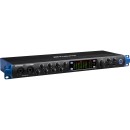
PreSonus Studio 1824c |
VS | ||
|---|---|---|---|
| Analog: 8 Inputs / 10 Outputs at 192 kHz Digital: 10 Inputs / 10 Outputs at 48 kHz |
Channels of I/O |
Analog: 8 Inputs / 10 Outputs Digital: 10 Inputs / 10 Outputs |
Analog: 8 Input / 6 Output at 192 kHz Digital: 10 Input / 2 Output |
| 192 kHz / 24-Bit | Maximum Sampling Rate | 192 kHz / 24-Bit | 192 kHz / 24-Bit |
| 8 Preamps | Number of Microphone Inputs | 8 Preamps | 4 Preamps |
| 2x Combo XLR-1/4" TRS Balanced/Unbalanced Mic/Line/Hi-Z Input (Front Panel) 6x Combo XLR-1/4" TRS Balanced Mic/Line Input 2x 1/4" TRS Balanced Monitor Output (DC-Coupled) 8x 1/4" TRS Balanced Line Output (DC-Coupled) 2x 1/4" TRS Unbalanced Headphone Output |
Analog Audio I/O |
2x Combo XLR-1/4" TRS Balanced/Unbalanced Mic/Line/Hi-Z Input 6x Combo XLR-1/4" TRS Balanced Mic/Line Input 10x 1/4" TRS Balanced/Unbalanced Line/Monitor Output 2x 1/4" TRS Unbalanced Headphone Output |
2x Combo XLR-1/4" TRS Balanced/Unbalanced Mic/Line/Hi-Z Input (Front Panel) 2x Combo XLR-1/4" TRS Balanced Mic/Line Input (Front Panel) 4x 1/4" TRS Balanced Line Input 4x 1/4" TRS Balanced Line Output 2x 1/4" TRS Unbalanced Headphone Output (Front Panel) |
| 1x TOSLINK Optical ADAT Input (S/MUX Support) 1x TOSLINK Optical ADAT Output (S/MUX Support) 1x RCA Coaxial S/PDIF Input 1x RCA Coaxial S/PDIF Output |
Digital Audio I/O |
1x RCA Coaxial S/PDIF Input 1x RCA Coaxial S/PDIF Output 1x TOSLINK Optical ADAT / S/PDIF Input (S/MUX Support) 1x TOSLINK Optical ADAT Input (S/MUX Support) 1x TOSLINK Optical ADAT / S/PDIF Output (S/MUX Support) 1x TOSLINK Optical ADAT Output (S/MUX Support) |
1x RCA Coaxial S/PDIF Input 1x RCA Coaxial S/PDIF Output 1x TOSLINK Optical ADAT Input |
| 1x USB-C (Class-Compliant) | Host Connection | 1x USB-C | 1x USB-C |
| macOS 10.13 or Later (64-Bit Only) Windows 10 (64-Bit Only) 10 or Later 6 or Later |
OS Compatibility |
macOS 10.12 macOS 10.13 macOS 10.14 macOS 10.15 macOS 11 Windows 7 or Later |
macOS 10.12 or Later Windows 7 or Later iPadOS |
| AC/DC Power Adapter (Included) | Power Requirements | AC Input | AC/DC Power Adapter (Included) |
